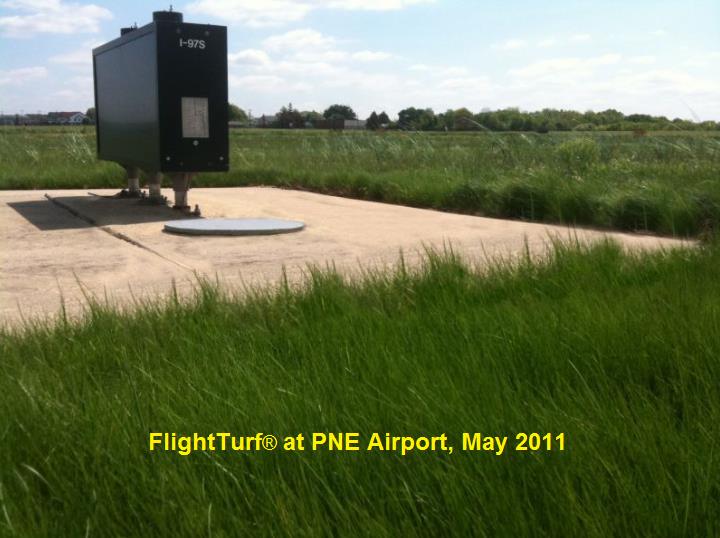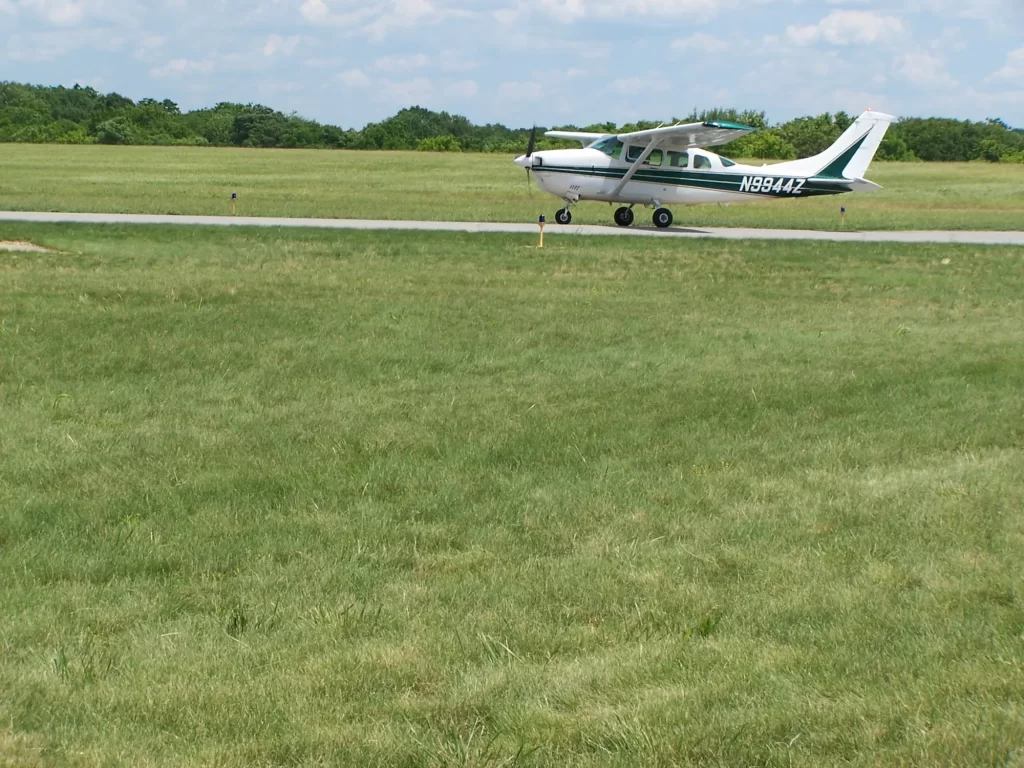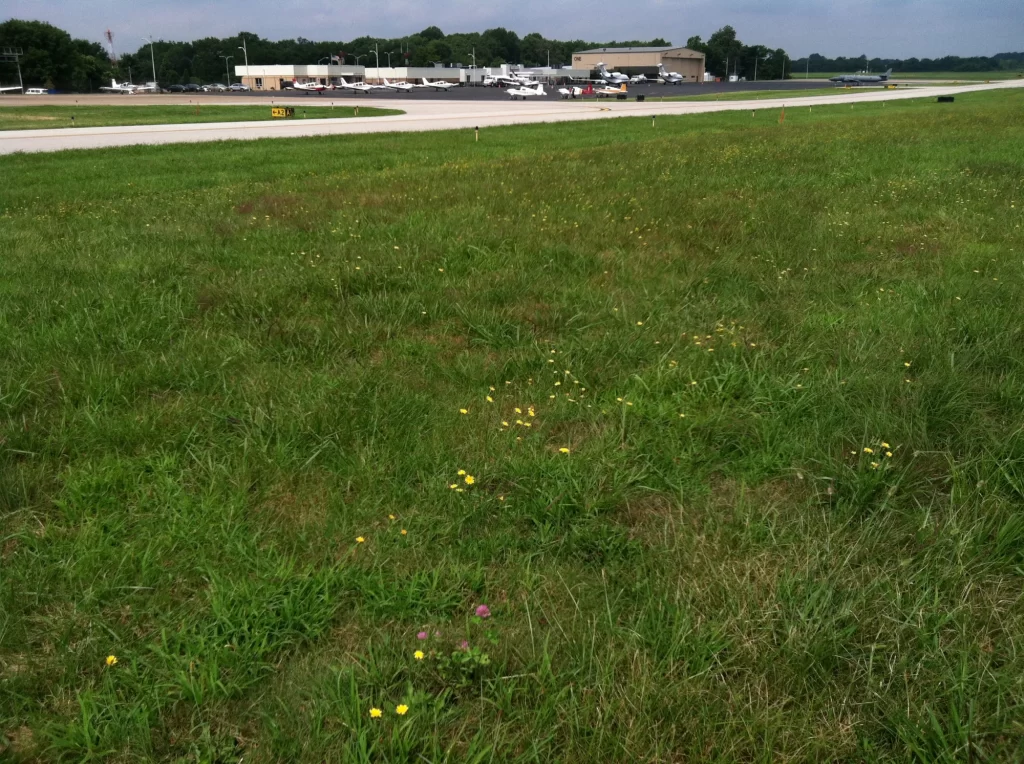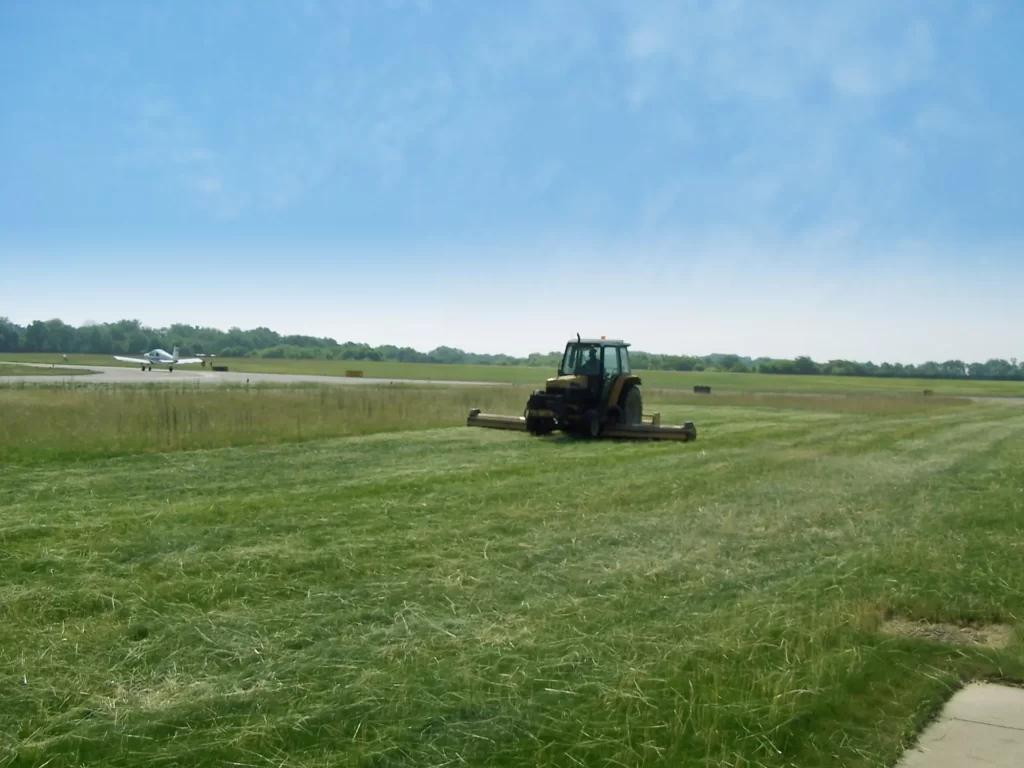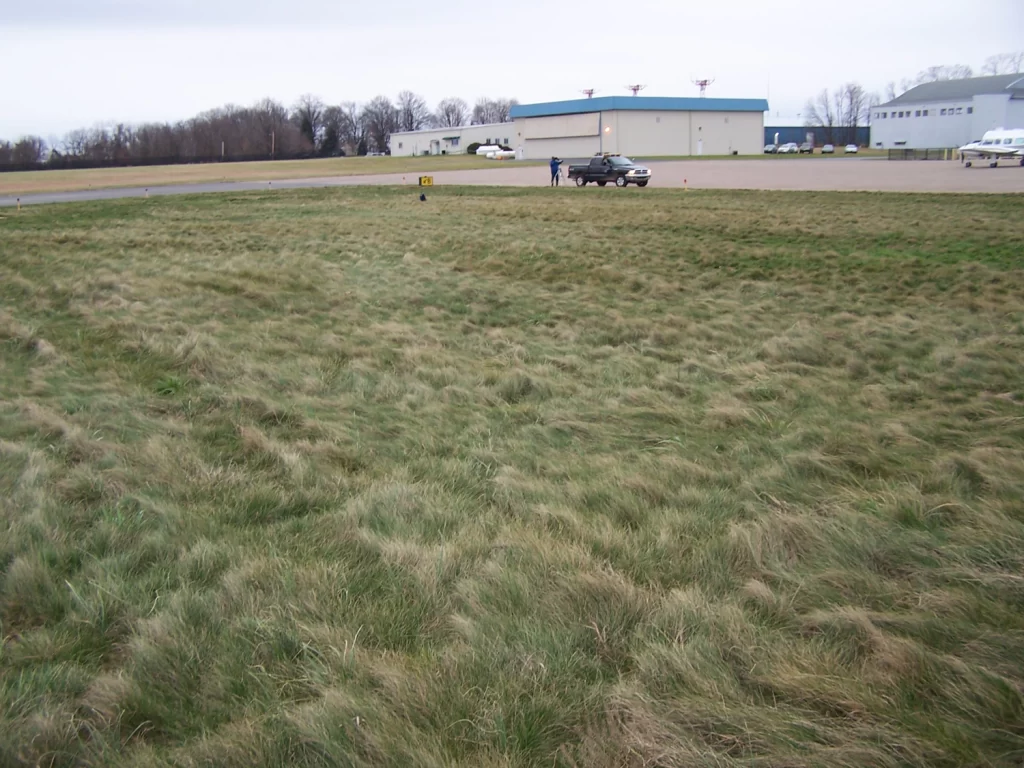Case Study
Northeast Philadelphia Airport (PNE)
For the City of Philadelphia Division, Division of Aviation
Study Site
Northeast Philadelphia Airport – City of Philadelphia, Division of Aviation
Reasons for Evaluation
To evaluate FlightTurf® as a safer, lower-maintenance, and more environmentally beneficial vegetative cover than existing conventional airfield turfgrass for use at airports owned by the Philadelphia Division of Aviation. Specifically, to determine if FlightTurf® would achieve its goal of nearly eliminating mowing without attracting wildlife.
Mowing is costly.
- Philadelphia International Airport (PHL) mows its airfields 22 times a year, and at $38 per acre each mow, spent over $725,000 in 2010 on mowing and maintenance services.
- Mowing both PHL and PNE cost the City of Philadelphia over $1M in 2010.
Mowing is unsafe.
The U.S. Department of Agriculture, Wildlife Services recognizes the safety risks in mowing:
- Mowing equipment causes runway incursion, and sometimes runway or airport closure.
- Flushing of insects from mowing attracts birds.
- Straw clippings from mowing can clog jet engines and attract birds using it for nesting material.
Mowing is harmful to the environment.
- Frequent mowing results in shorter turf root systems, adding to stormwater runoff on airfields, and polluting waterways.
- Exhaust emissions pollute the air.
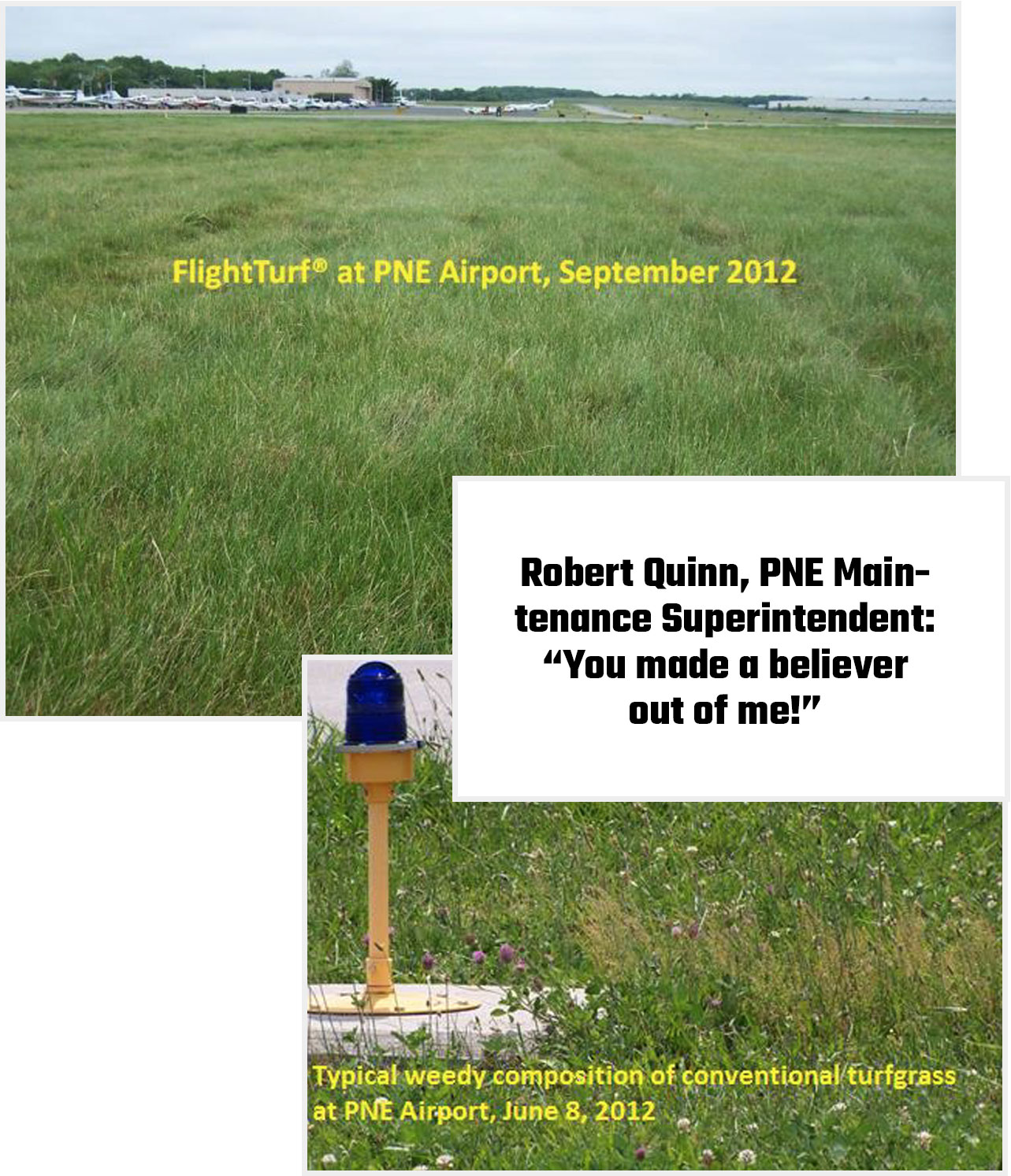
Study Summary
Beginning in 2009, Native Return® seeded approximately three acres of FlightTurf® on the PNE Airport airfield to determine if FlightTurf® would:
- establish successfully alongside the runway;
- average no taller than 7” in grass blade height;
- require only one annual mow;
- not be more of a wildlife attractant than existing turfgrass.
From 2009 through 2012, monitoring and collection of field data from replicated experimental (FlightTurf®) and control (existing turfgrass) plots took place every two weeks. This included dusk and dawn point counts to measure wildlife. Data was compiled into reports including histograms depicting bird data, which were submitted to the Federal Aviation Administration for review.
Study Results
- FlightTurf® met its goal of reduced maintenance without attracting more wildlife than existing conventional turfgrass. FlightTurf® established successfully, and attracted less wildlife once it matured than existing turf. By 2012, no birds were observed on the airside experimental plots, while birds continued to visit the airside control plots. This favorable result was obtained even though the experimental plots were mowed as little as once a year, while the control plots required weekly or biweekly mowing throughout the March to November growing season.
- FlightTurf® maintained an average 7” height with as little as one annual mow. This can equate to dramatic savings for PHL Airport alone – more than $800 per acre per year, or about $695,000 annually – a 96% savings.
- FlightTurf® plots were relatively grasshopper-free, whereas the control plots all supported large populations of grasshoppers, which are known wildlife attractants.
- FlightTurf® was persistent and durable, remaining thick, even with moderate vehicle traffic.
- FlightTurf® performed well year round with no supplemental irrigation. FlightTurf® was drought resistant and sun tolerant.
- FlightTurf® required minimal chemical treatment and was weed resistant in areas where proper FlightTurf® maintenance protocols were followed.
Independent Study Review for the Philadelphia Division of Aviation
- TRC Engineers, Inc. – TRC Engineers, Inc. reviewed the final year of the FlightTurf® study for Philadelphia DOA. In a letter dated March 4, 2013, to Philadelphia Deputy Director of Aviation Calvin Davenger, TRC Director of Operations Robert Goldman writes, “TRC has concluded that the airside turf grass plots [FlightTurf®] have indeed been a success in terms of reducing the need for maintenance without increasing the presence of wildlife.”
- Federal Aviation Administration (FAA) – Native Return® submitted its findings to the FAA. FAA Manager of the Airport Safety and Operations Division, Brian Rushforth, notes in a June 18, 2012 email the FAA has not found any evidence that FlightTurf® causes any increase in wildlife and consequently allows its use on airfields.
- Philadelphia Department of Public Property – Deborah Cahill, ASLA, a Landscape Architect with the Philadelphia Department of Public Property, offered her assessment of FlightTurf®:
“Christina [Christina Kobland, President of Native Return®] and I visited PNE in the summer of 2012, with record temperatures and drought conditions. Turf normally becomes dormant when these environmental conditions persist for a long period of time. Dormancy includes browning of the blades and an increase of invasive species. FlightTurf® did not exhibit any of those negative attributes.”
Deborah Cahill, ASLA, a Landscape Architect with the Philadelphia Department of Public Property
- Urban Engineers, Inc. – Urban Engineers, Inc. was hired by the Philadelphia Division of Aviation to (1) review the alternative airfield turfgrass (FlightTurf®) study and (2) compare costs of mowing existing conventional turfgrass at its two airports – Philadelphia International Airport (PHL) and Northeast Philadelphia Airport (PNE) – to the costs of establishing and maintaining FlightTurf® at both airports. According to Urban Engineer’s final detailed analysis based on operations data entitled Update of Benefit-Cost Analysis and dated February, 2012:
- Philadelphia International Airport (PHL) mows its airfields 22 times a year, and at $38 per acre each mow, spent over $725,000 in 2010 on mowing and maintenance services. Mowing both PHL and PNE cost the City of Philadelphia over $1M in 2010.
- Urban writes, “The benefit-cost analysis of the conversion of airfield grass to a lower growing, lower maintenance seed mix [FlightTurf®] demonstrates significant economic savings, particularly if airfields at PNE and PHL were reseeded with the new seed mix. This is provided that a relatively economical monitoring and maintenance effort be adhered to upfront to ensure that a full stand of the new turf is established.”
- Urban writes, “Initial costs of establishing the lower growing, alternative turfgrass [FlightTurf®] would be made up within one (1) year as compared to the cost of establishing a new stand of traditional turfgrass, or 2 to 3 years for replacing an existing stand of traditional turfgrass when considering the potential long term savings in maintenance (in 2010 dollars, and assuming an FAA standard 7% discount rate.) Annual reductions in maintenance costs per acre would be approximately 95% of what they are today through the reduction in mowing to once per year.”
- Urban writes, “As fuel prices increase, the actual dollars in cost savings resulting from reduced mowing will also increase.”
Lessons Learned
- Too frequent mowing damages FlightTurf® and permits weedy intrusion. Operations personnel need to be taught to follow reduced maintenance protocols. Distribution of written maintenance protocols helps to prevent mistakes.
- Budgets should include approximately $200 per acre for monitoring and maintenance (if necessary) in each of the first three years after seeding to ensure establishment of a thick, weed-free monostand of FlightTurf®.
- Best results are achieved when airport planning, engineering and operations personnel all understand the installation and long term management techniques particular to FlightTurf® systems.
- Reductions in mowing and wildlife maximize after FlightTurf® matures into a self-sustaining weed-free monostand, which can take from one to three years.
Study Conclusions
As larger areas are converted to FlightTurf®:
- Airport profitability will significantly increase.
- Airports save approximately $800 per acre each year with reductions in mowing
- Urban Engineer’s study for Philadelphia revealed: (1) cost recovery within one year in new construction projects, and (2) cost recovery within two to three years for conversions of existing turf to FlightTurf®.
- Airport safety will significantly increase.
- Reductions in runway closures and the hazards involved with mowing are key benefits.
- The FlightTurf® method of turf management results in an airfield less attractive to wildlife. Congregating wildlife tend to flock elsewhere, reducing the threat of bird strikes.
- Airport environmental benefits will significantly increase.
- Deep root systems allow FlightTurf® to effectively infiltrate storm water, remove pollutants, stabilize the soil, and survive droughts.
- Greenhouse gas emissions are reduced in proportion to decreases in mowing frequency.

